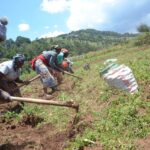
By George Juma | jumageorge10@gmail.com
The Kenya Forest Service (KFS) plans to raise 15 billion tree seedlings at a cost of Ksh500 billion ($4 billion) in the next 10 years in a bid to achieve a 30 per cent forest cover by 2032.
KFS Deputy Chief Conservator in charge of Advisory and County Liaison Beatrice Mbula said the service currently has about 300 seedling nurseries.
Speaking during a MESHA science café at the KFS headquarters in Nairobi, Mbula said they are going to work closely with individuals, groups and county governments to raise the 15 billion seedlings within the targeted timeline.
Merceline Alumba, an officer in charge of plantation management KFS said they are also using the Plantation Establishment and Livelihood Improvement Scheme (PELIS) – also known as the shamba system – where communities living around forests are given a section of the forest to plant food crops as they manage the trees to increase forest cover.
Alumba said this strategy has worked and they now have 10,000 hectares of land under PELIS across the country.
She said the country will be able to achieve the 30 per cent forest cover by 2032 if all the stakeholders, including the general public, work jointly with the government.
Alumba said the land under the government owned forests is small and therefore the only way to increase the forest cover is through individuals’ parcels.
Currently Kenya has a forest cover of about 8.3 per cent that sits on 5.2 million hectares of land. Out of this, the government manages 2.6 million hectares while the remaining 2.6 million is under private land.
Even as the government is moving with speed to plant more trees in a bid to deal with the effects of climate change, encroachment of forests remains a major threat to these efforts. Many forests in the country have been degraded by human activities such as logging.
Mbula said KFS is planning to use a digital system to monitor activities in forests. She said the technology, which is still being piloted in Kwale, is going to help the Service to monitor all activities in forests, including poaching, logging and planting of trees.
She said the technology presents a new opportunity in the fight against poaching in the forests across the country.
Mbula said the Kenya Forest Service is also planning to hire additional 2,700 rangers as directed by President William Ruto during Mashujaa Day celebrations on October 20.








